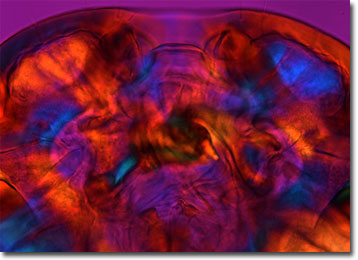Polarized Light Microscopy Digital Image Gallery
Canine Biting Louse (Trichodectes canis)
Unlike most ticks and other parasites, the 2,800 species of biting lice that have been identified worldwide are very host-specific. Trichodectes canis, which belongs to the wingless insect suborder Mallophaga, is the louse species that most commonly feeds upon domestic dogs, as well as wild canids such as wolves, coyotes, jackals, and foxes.

The canine biting louse has a dorsoventrally flattened body and a broad head, which together measure about 1.5 millimeters in length. The antennae of the tiny insect are quite prominent and each of its six legs is equipped with a powerful claw that enables the louse to hold tightly to its host, even when the canine is furiously trying to scratch or bite it away. As its classification as a biting louse implies, this species is also equipped with large, opposing mandibles that it utilizes to feed upon skin cells, hair fragments, and blood. For digestion to take place, however, the insect requires the help of symbiotic bacteria that are typically found in specialized mycetocytes. When deprived of these symbionts, the louse is sure to perish within a short period.
Infestations of Trichodectes canis most commonly occur among poorly nourished animals, but may also occasionally plague healthy individuals as well. The typical signs of the presence of these annoying pests are incessant itching and sleep loss. Rendering the insects an even greater nuisance is their ability to cause anemia and to act as an intermediate host for Dipylidium caninum, the common tapeworm that infects dogs and cats. Animals that are suffering from the presence of the parasitic lice can usually be successfully treated with two applications of an insecticidal shampoo. The second of these applications should be applied 14 days after the first in order to eradicate the lice that emerge from newly hatched eggs.
